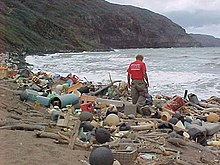Debris
This article needs additional citations for verification. (November 2014) |
Debris (UK: /ˈdɛbriː, ˈdeɪbriː/, US: /dəˈbriː/) is rubble, wreckage, ruins, litter and discarded garbage/refuse/trash, scattered remains of something destroyed, or, as in geology, large rock fragments left by a melting glacier, etc. Depending on context, debris can refer to a number of different things. The first apparent use of the French word in English is in a 1701 description of the army of Prince Rupert upon its retreat from a battle with the army of Oliver Cromwell, in England.[1]
Disaster
In disaster scenarios, tornadoes leave behind large pieces of houses and mass destruction overall. This debris also flies around the tornado itself when it is in progress. The tornado's winds capture debris it kicks up in its wind orbit, and spins it inside its vortex. The tornado's wind radius is larger than the funnel itself. Tsunamis and hurricanes also bring large amounts of debris, such as Hurricane Katrina in 2005 and Hurricane Sandy in 2012. Earthquakes rock cities to rubble debris.
Geological

In
In mining, debris called attle usually consists of rock fragments which contain little or no ore.
Marine

Marine debris applies to floating garbage such as
waste solids.In addition to being unsightly, it can pose a serious threat to marine life,
The largest concentration of marine debris is the
Marine debris most commonly originates from land-based sources. Various international agencies are currently working to reduce marine debris levels around the world.
Meteorological
In
Space
Space debris usually refers to the remains of
A debris disk is a circumstellar disk of dust and debris in orbit around a star.
Surgical
In
War

In the aftermath of a war, large areas of the region of conflict are often strewn with war debris in the form of abandoned or destroyed hardware and vehicles, mines, unexploded ordnance, bullet casings and other fragments of metal.
Much war debris has the potential to be lethal and continues to kill and maim civilian populations for years after the end of a conflict. The risks from war debris may be sufficiently high to prevent or delay the return of refugees. In addition war debris may contain hazardous chemicals or radioactive components that can contaminate the land or poison civilians who come into contact with it. Many
In November 2006 the Protocol on Explosive Remnants of War[2] came into effect with 92 countries subscribing to the treaty that requires the parties involved in a conflict to assist with the removal of unexploded ordnance following the end of hostilities.[3]
Some of the countries most affected by war debris are Afghanistan, Angola, Cambodia, Iraq and Laos.
Similarly military debris may be found in and around
Debris can also be used as cover for military purposes, depending on the situation.
Culinary
In South Louisiana's
See also
References
- ^ Warwick, Sir Philip. (1701). Memoires of the Reigne of King Charles I: With a continuation to the happy restoration of King Charles II. London: Ri.Chiswell. p. 208.
- ^ "Protocol on Explosive Remnants of War (Protocol V to the 1980 Convention)". International Committee of the Red Cross. 2003. Retrieved 2006-06-20.
- ^ "War Debris Treaty To Come Into Force in November". Defense News. 2006. Retrieved 2006-06-20.[dead link]
